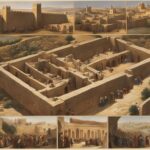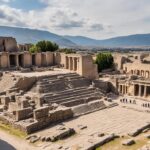Welcome to our exploration of the biblical significance of Pella. Situated in the Perean foothills of the Jordan River, Pella holds a unique place in history and serves as a testament to the enduring faithfulness of God. In this article, we will delve into the biblical references and historical context of Pella, uncovering its role as an ancient refuge and a fulfillment of prophecy.
Pella’s biblical history dates back to the time of Jesus and the destruction of Jerusalem. As the city faced impending destruction, Pella became a place of refuge for Jesus’ followers, providing safety and protection. The biblical prophecies found in the Synoptic Gospels urged the followers to flee to the mountains, and Pella became their refuge.
Eusebius’s Church History documents that the Jewish followers of Jesus heeded the warning and sought shelter in Pella before the devastation of Jerusalem. This event showcases the providence of God and the fulfillment of prophecy.
Pella is also mentioned in the book of Revelation, where it is associated with the escape of the women’s offspring from the dragon’s attempts to destroy them. Pella is seen as a place of refuge provided by the Gentile churches of the Decapolis, highlighting its significance in the biblical narrative.
Key Takeaways:
- Pella held historical and biblical significance as a city of refuge during the destruction of Jerusalem.
- Biblical prophecies urged Jesus’ followers to escape to Pella for their safety.
- Pella’s role in the book of Revelation emphasizes its association with refuge and deliverance.
- Eusebius’s Church History documents the Jewish followers of Jesus seeking shelter in Pella before Jerusalem’s destruction.
- Pella’s biblical references highlight the providence and faithfulness of God in times of crisis.
Historical Significance of Pella
Pella is steeped in historical significance, particularly in biblical times. It played a pivotal role as a city of refuge for Jesus’ followers prior to the destruction of Jerusalem. Early Church Fathers such as Eusebius and Epiphanius have cited the tradition of the flight to Pella as a means of escaping the imminent calamity.
“Pella stands as a testament to the importance of finding safety and solace during times of crisis.”
— Eusebius, Church History
This historical event underscores the crucial role that Pella played as a place of safety and sanctuary during tumultuous times.
| Key Points | Significance |
|---|---|
| Pella as a city of refuge | Pella served as a sanctuary for Jesus’ followers, providing safety and protection amidst the destruction of Jerusalem. |
| Escape from impending calamity | The flight to Pella enabled Jesus’ disciples to avoid the devastating fate that awaited Jerusalem, fulfilling biblical prophecies. |
| Historical documentation | Early Church Fathers have referenced the flight to Pella, affirming its historical significance and importance in the biblical narrative. |
Pella stands as a testament to the importance of finding safety and solace during times of crisis. Its historical significance as a city of refuge highlights the resilience and faith of those seeking sanctuary within its walls.
Geographical Location of Pella
Pella is rich in history and is located in northwestern Jordan, nestled within the picturesque Perean foothills of the Jordan River. Situated just outside Tabaqat Fahl, this ancient city lies approximately twenty miles south of the renowned Sea of Galilee.
The geographical setting of Pella is truly astounding, providing a natural mountainous retreat that aligns with the prophecy of Jesus as a city of refuge. Visitors to Pella can enjoy breathtaking views of the surrounding region, including the stunning panorama of the Jordan Valley. To the northwest, the majestic Mount Gilgal stands tall, while the northeast horizon is dominated by the imposing presence of Beth-Shean, also known as Scythopolis.
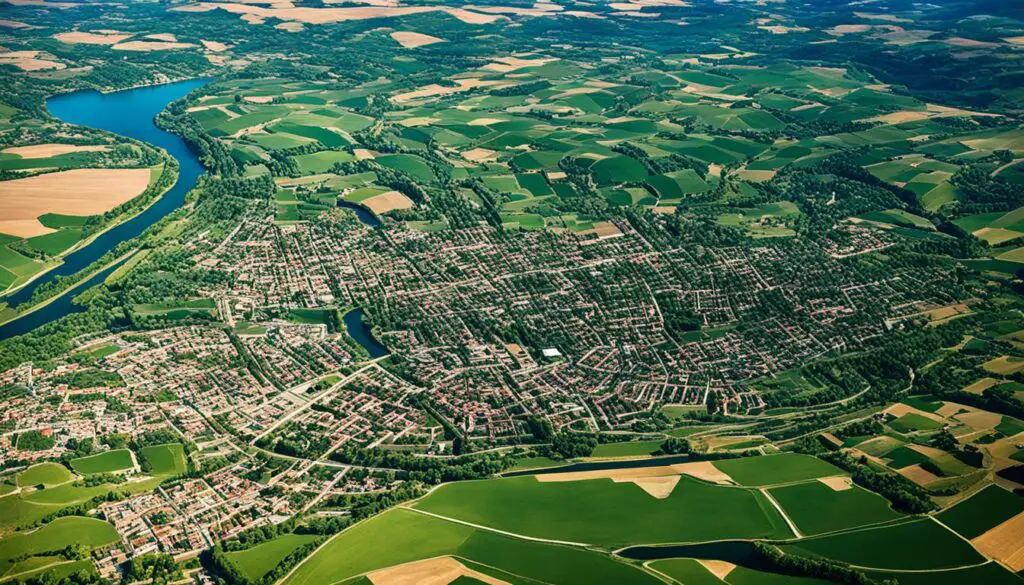
Archaeological Discoveries in Pella
The University of Sydney has been conducting excavations at Pella since 1979, unearthing fascinating archaeological discoveries that shed light on the ancient history of the city. These excavations have revealed remnants of various civilizations spanning over 10,000 years, from the Natufian period to the Islamic period.
Although some Roman buildings from the late first century C.E. have been lost due to later constructions, several significant relics have been uncovered. Notable remains include a Roman odeon, a bathhouse, and a necropolis.
One of the most intriguing findings is the discovery of Roman milestones in the nearby hills, indicating direct connections between Pella and the Decapolis city of Gerasa (modern Jerash). This suggests that Pella played a significant role in the region’s trade and transportation network during the Roman period.
Archaeological Discoveries in Pella
| Period | Discoveries |
|---|---|
| From Natufian to Islamic period | Wide range of archaeological discoveries |
| Late first century C.E. | Remnants of Roman odeon, bathhouse, and necropolis |
| Roman period | Discovery of Roman milestones |
Theological Themes in Pella
Pella carries significant theological themes in the biblical narrative, particularly in its role as a place of refuge for Jesus’ followers. The biblical significance of Pella encompasses themes of protection, safety, and deliverance in times of crisis.
The flight to Pella is seen as a fulfillment of Jesus’ prophecy and a demonstration of divine care for His followers. As mentioned in the book of Revelation, the escape to Pella symbolizes the protection of the Jerusalem church from the dragon’s attempts to destroy them. This highlights the providence and faithfulness of God in preserving His people amidst challenging circumstances.
**“”Pella serves as a powerful reminder of God’s unwavering commitment to His followers, offering them a place of safety and hope in the face of adversity.”**
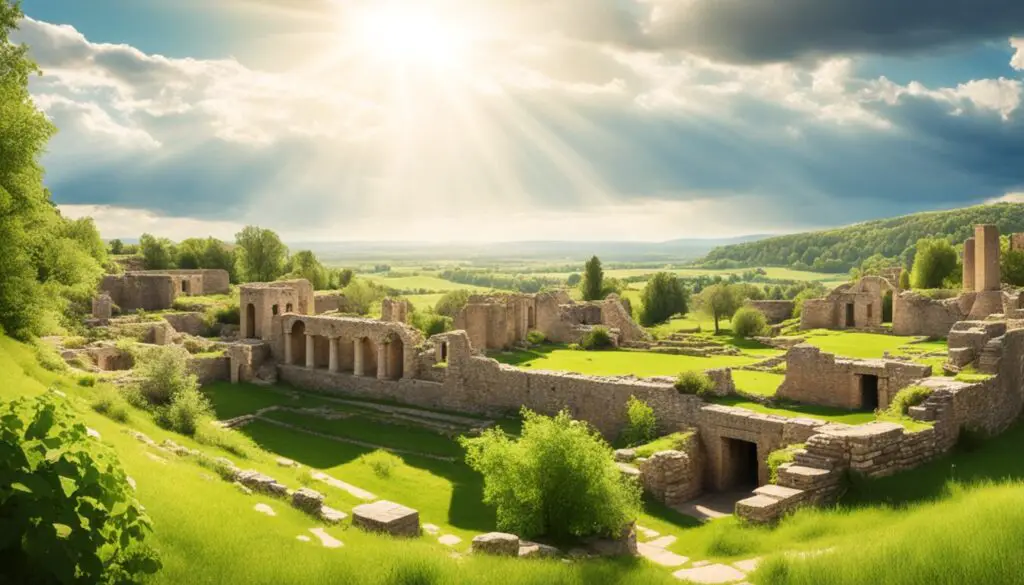
| Theological Themes in Pella | Biblical Significance of Pella | Pella in Religious Context |
|---|---|---|
| Protection and Safety | The fulfillment of Jesus’ prophecy and the escape to Pella demonstrate God’s protection over His followers. | Pella’s significance is rooted in the religious narrative, emphasizing divine care and intervention. |
| Deliverance | The flight to Pella represents deliverance from impending destruction and the preservation of Jesus’ faithful followers. | Pella’s role as a place of refuge highlights the hope and deliverance found through faith. |
| Divine Providence | Pella’s inclusion in biblical prophecies and its association with the protection of the Jerusalem church underscores God’s providential plan. | Pella attests to the divine guidance and provision extended to those who seek refuge in Him. |
Key Biblical Events in Pella
Although the New Testament does not explicitly mention Pella, it is believed that Jesus may have visited this ancient city during His time in the Decapolis and Perea regions. The proximity of Pella to these areas and its secure location make it a plausible destination for Jesus’ visit. While the exact details remain unknown, the significance of Pella lies in its association with a crucial biblical event—the flight of Jesus’ followers to Pella before the destruction of Jerusalem.
This event highlights the importance of Pella in the life of Jesus and the early Christian community. Pella served as a place of refuge and safety, providing protection for those who heeded Jesus’ warning. The flight to Pella before the fall of Jerusalem demonstrates the Biblical significance of the city in providing a sanctuary during times of crisis.

While Pella’s direct involvement in the life and ministry of Jesus remains speculative, its role as a safe haven for His followers cements its place in biblical history. The events associated with Pella testify to the city’s purpose in sheltering and preserving the early Christian community during tumultuous times.
Cultural and Religious Practices in Pella
While specific cultural and religious practices in Pella during biblical times are not explicitly documented, it can be inferred that the Jewish followers of Jesus who sought refuge in Pella would have continued their adherence to Jewish customs and traditions. Pella likely maintained a Jewish-Christian community, and their practices would have been influenced by both Jewish and Christian traditions. These practices would have played a significant role in shaping the cultural and religious landscape of Pella during biblical times.
Prophetic and Eschatological Significance of Pella
Pella, mentioned in the biblical narrative, carries profound prophetic and eschatological significance. Jesus’ prophecy about the impending destruction of Jerusalem and the urgent call to flee to the mountains finds its fulfillment in the flight to Pella. This event stands as a powerful testament to the precise fulfillment of biblical prophecies and serves as a vivid illustration of God’s sovereignty and protection over His people.
The escape to Pella not only reflects the fulfillment of specific prophecies but also forms an integral part of the larger eschatological framework. It underscores the ultimate return of Jesus and the establishment of His kingdom, bringing hope and reassurance to believers.
In the words of Jesus, “And they will fall by the edge of the sword and be led captive among all nations, and Jerusalem will be trampled underfoot by the Gentiles until the times of the Gentiles are fulfilled” (Luke 21:24). The flight to Pella exemplifies the preservation of God’s chosen people amidst tribulation, marking a significant milestone in the unfolding of eschatological events.
“Fulfilling ancient prophecies and encapsulating the divine plan for the ages, Pella served as the sanctuary of hope during a time of unparalleled turmoil. It remains a testament to God’s faithfulness and the ultimate fulfillment of His promises.”
The eschatological significance of Pella is a compelling reminder of the enduring faithfulness of God and the ultimate deliverance of His people. It serves as a beacon of hope in troubled times and an anchor for the believers’ steadfast trust in the promises of Scripture.
| Prophecy | Fulfillment |
|---|---|
| The destruction of Jerusalem | The flight of Jesus’ followers to Pella |
| The preservation of God’s people | God’s providence and protection in Pella |
| The times of the Gentiles | The eventual return of Jesus and establishment of His kingdom |
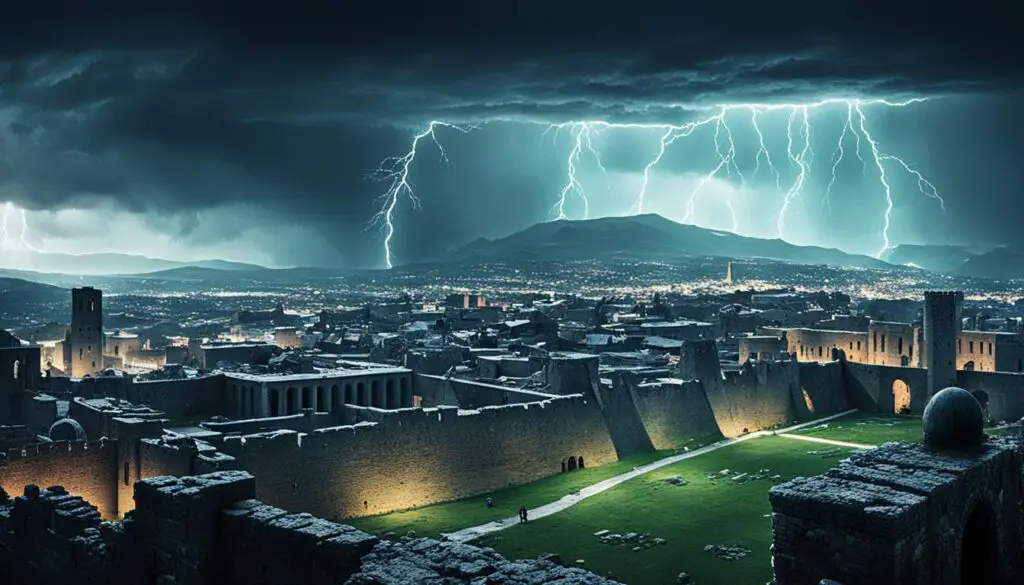
Pella as a Symbol of Refuge and Hope
Pella, both in biblical times and in its modern manifestation, stands as a symbol of refuge and hope in times of great crisis. The flight to Pella during the destruction of Jerusalem showcased the city as a place of safety for Jesus’ followers. The modern city of Pella in Iowa, founded by Dutch immigrants seeking religious freedom, draws its name from its biblical counterpart. This connection emphasizes the enduring symbol of refuge and hope that Pella represents, both historically and in contemporary contexts.

“Pella provided solace and protection for those seeking safety amidst chaos and destruction. Its significance as a symbol of refuge cannot be understated.”
Historical and Biblical Significance
Pella’s role as a symbol of refuge is rooted in its historical and biblical significance. During the fall of Jerusalem, Pella provided a sanctuary for Jesus’ followers, allowing them to escape the devastating destruction of the city. This event resonates with the human need for hope and sanctuary in times of crisis, highlighting Pella as a beacon of safety and solace.
A Place of Hope
Pella not only offered physical refuge but also served as a place of hope for the persecuted and marginalized. Its founding principle, rooted in the pursuit of religious freedom, demonstrates the enduring power of hope in shaping communities. The story of Pella, both biblical and modern, serves as a reminder that hope can flourish even in the darkest of times.
“Pella stands as a testament to the resilience of the human spirit and the transformative power of hope. It has become a symbol of sanctuary, inspiring individuals and communities to seek refuge and find hope in the face of adversity.”
Significance in Times of Crisis
Pella’s significance as a symbol of refuge and hope is amplified during times of crisis. Whether in biblical times or in the present day, Pella’s legacy reminds us of the importance of providing sanctuary and support to those in need. It challenges us to be a source of hope and comfort for others, just as Pella has symbolized throughout history.
“In a world filled with uncertainties and challenges, Pella’s enduring symbolism as a place of refuge and hope serves as a reminder of our shared humanity and the potential for compassion and kindness to prevail even amidst the darkest hours.”
| Key Points | Implications |
|---|---|
| Pella as a place of safety during the destruction of Jerusalem | Illustrates the importance of finding refuge in times of crisis |
| Pella in Iowa as a modern embodiment of hope and sanctuary | Highlights the enduring legacy of Pella’s symbolism |
| Pella’s significance in providing solace and protection | Emphasizes the need for compassionate and supportive communities |
Conclusion
Pella, situated in the Perean foothills of the Jordan River, holds significant historical and biblical significance. As a city of refuge, it provided a safe haven for Jesus’ followers during the destruction of Jerusalem, fulfilling biblical prophecies and demonstrating the providence of God. The archaeological discoveries in Pella have unearthed its ancient past, offering valuable insights into its historical context. Furthermore, the theological themes associated with Pella highlight its importance in the biblical narrative.
Today, Pella serves as a symbol of refuge and hope, not only in biblical times but also in contemporary contexts. The flight to Pella exemplifies the enduring faithfulness of God and His care for His people in times of crisis. Its name and legacy are carried forward to the modern city of Pella in Iowa, which was founded by Dutch immigrants seeking religious freedom. This connection between past and present underscores the enduring significance of Pella.
In summary, Pella’s location, archaeological discoveries, and theological themes make it a place of remarkable historical and biblical significance. The city’s role as a refuge for Jesus’ followers during the destruction of Jerusalem showcases the fulfillment of biblical prophecies and the faithfulness of God. Pella stands as a symbol of refuge and hope, reminding us of the enduring legacy and unwavering providence of God in our lives.
FAQ
What is the biblical significance of Pella?
Pella holds historical and biblical significance as it served as a city of refuge for Jesus’ followers when they escaped the destruction of Jerusalem. It is mentioned in the Synoptic Gospels and is associated with biblical prophecies about the destruction of Jerusalem and the call to flee to the mountains.
Where is Pella located in biblical times?
Pella is located in the Perean foothills of the Jordan River in northwestern Jordan, outside Tabaqat Fahl and approximately twenty miles south of the Sea of Galilee.
What are some archaeological discoveries in Pella?
Excavations at Pella have revealed a wide range of archaeological discoveries spanning over 10,000 years. While few Roman buildings remain, remnants of a Roman odeon, bathhouse, and necropolis have been found, along with Roman milestones indicating connections between Pella and the Decapolis city of Gerasa (Jerash).
What are the theological themes associated with Pella?
Pella holds theological significance as it served as a place of refuge for Jesus’ followers, emphasizing themes of protection, safety, and deliverance in times of crisis. The flight to Pella is seen as a fulfillment of Jesus’ prophecy and a demonstration of divine care for His followers.
Did Jesus visit Pella?
While there is no explicit mention of Jesus visiting Pella in the New Testament, some speculate that He may have visited during His time in the Decapolis and Perea. The flight of Jesus’ followers to Pella before the destruction of Jerusalem is a significant biblical event associated with the city.
What were the cultural and religious practices in Pella during biblical times?
The specific cultural and religious practices in Pella during biblical times are not explicitly documented. However, it can be inferred that the Jewish followers of Jesus who sought refuge in Pella would have continued their adherence to Jewish customs and traditions.
What is the prophetic and eschatological significance of Pella?
Pella holds prophetic and eschatological significance as the flight of Jesus’ followers to Pella during the destruction of Jerusalem fulfilled biblical prophecies. This event highlights God’s sovereignty and protection over His people and is connected to the larger eschatological framework of the eventual return of Jesus and the establishment of His kingdom.
What does Pella symbolize in biblical times?
Pella symbolizes refuge and hope in times of great crisis. The flight of Jesus’ followers to Pella during the destruction of Jerusalem showcased the city as a place of safety. The modern city of Pella in Iowa, founded as a symbol of religious freedom, draws its name from its biblical counterpart, emphasizing the enduring symbol of refuge and hope.



